Priority Products for Sustainability Information and Recommendation Software: Insights in the Context of the EU’s Action Plan Circular Economy
Abstract
1. Introduction
1.1. Sustainable Development and Information Technology
1.2. Literature Review and Research Gap
1.2.1. Sustainability Perspectives
1.2.2. Priority Products for Sustainability Goals and Related Information Needs
1.2.3. Digital Sustainability Information and Recommendation Software
- ‘Building on the single market and the potential of digital technologies, the circular economy can strengthen the EU’s industrial base’. (p. 4)
- ‘Innovative models based on a closer relationship with customers, mass customisation, (…) and powered by digital technologies, such as the internet of things, big data, blockchain and artificial intelligence, will not only accelerate circularity but also the dematerialisation of our economy and make Europe less dependent on primary materials.’ (p. 4)
- ‘A whole new range of sustainable services, product-as-service models and digital solutions will bring about a better quality of life, innovative jobs and upgraded knowledge and skills.’ (p. 5)
- ‘The Commission will consider establishing sustainability principles and other appropriate ways to regulate the following aspects: (…) mobilising the potential of digitalisation of product information, including solutions such as digital passports, tagging and watermarks’. (p. 7)
1.2.4. Research Gap, Questions, and Hypothesis
2. Materials and Methods
2.1. Application of an Exploratory Survey Research Method
2.2. Survey Participants
- Experts of ConCirMy core expert network: As described in Section 1.2.4, ConCirMy is a circular economy research project funded by the German Federal Ministry of Education and Research. Its partners established an extensive network of circular economy experts, including, e.g., circular economy lecturers and speakers at national Circular economy research workshops. ConCirMy’s network also includes bioeconomy researchers and those with circular-bioeconomic expertise, e.g., expressed by EU-level research.
- ReziProK experts: With the research concept ‘Resource-efficient circular economy’ (ReziProK), the German ministry BMBF supports the transformation of the German economy from a linear economy to a resource-efficient circular economy. A total of €150 million was dedicated to be used to fund new technologies and services, design concepts, and business models for the circular economy. The first funding measure, “Resource-efficient circular economy—innovative product cycles (ReziProK),” shall enable new business models, design concepts or digital technologies for closed product cycles. See [67] for details. The project RessWInn (Networking and transfer project for the BMBF funding measure “Resource-efficient recycling management—innovative product cycles [67]) is entrusted with supportive networking and transfer measures for these 25 ReziProK projects. On this basis, it helped to distribute the survey among ReziProK scientists.
- Experts of Germany’s Standardization Roadmap Circular Economy of DIN, DKE, and VDI. These persons passed an initial screening process at DIN and are regarded as recognized circular economy representatives in Germany.
- DECHEMA bioeconomy network: DECHEMA is Germany’s expert network for chemical engineering and biotechnology. As a non-profit professional society, it represents these fields in science, industry, politics, and the general public. DECHEMA promotes scientific and technical exchange among experts from different disciplines and consolidates the know-how of over 5800 individual and sustaining members, including a sub-group in the bioeconomy.
- EuBioNet: The European Bioeconomy Network (EuBioNet) is a proactive alliance of 108 EU-funded projects and initiatives dealing with bioeconomy promotion, communication, and support. The main goal is to maximise the efforts, increasing knowledge sharing, networking, mutual learning, and coordination of joint activities and events.
3. Results
3.1. Products Characterised by Specific Needs for Sustainability Information
3.2. Products Characterised by Specific Needs for Software to Support Sustainable Decisions and Drivers of the Need for Information
3.2.1. Relevant Products
3.2.2. Drivers of the Need for Information
3.3. Specific Information Needs
3.4. Specific Requirements in the Context of Bioplastics
4. Discussion
4.1. Implications for Four Target Groups
4.2. Contribution to Sustainability, CE, and Applied Software Research
4.3. Disclosure of Bottom-Up and Follow-Up Priorities in the Context of the CEAP
4.4. Contribution to Software Engineering
4.5. Contribution for Future Software Users
4.6. Limitations
5. Conclusions
- While scholars such as [10] demonstrated how sustainability might be measured (for example, of bio-based products), this article does not only show products for which specific needs for sustainability recommendation systems exist, but also refers to a recommendation system that may suggest products based on users’ specific sustainability interests.
- Ten factors influencing the need for sustainability information and facilitating further product-related sustainability classifications were unveiled.
- The EU’s 2020 New CE Action Plan and the priorities of the German Standardisation Roadmap Circular Economy are enriched by further insights facilitating practical implementations and decisions. This includes, in particular, the identification of priority areas where information based on specific additional indicators is needed.
- Qualitative, product-specific explanations on the need for software-based sustainability information was provided (Table 4), and, finally,
- Potential support for an emerging new need for car-related sustainability information and recommendations was unveiled.
Author Contributions
Funding
Institutional Review Board Statement
Informed Consent Statement
Data Availability Statement
Conflicts of Interest
Appendix A. Survey
- Survey on sustainable products and sustainability software
- Data protection
- A Getting started
- A.1 Which of the following keywords describes your professional role best?
- Management
- Administration/accounting
- Procurement
- Production
- Marketing
- Sales
- Research and development
- Other
- A.2 Please rate your familiarity with the circular economy:
| Very familiar | Moderately familiar | Somewhat familiar | Slightly familiar | Not at all familiar |
- A.3 Please rate your familiarity with the bioeconomy:
| Very familiar | Moderately familiar | Somewhat familiar | Slightly familiar | Not at all familiar |
- A.4 From your point of view, what are the most important products for which sustainability information is needed? Please note the products in the relevant category.
- Products with need for information on …
- … sustainability in general:
- … circularity (e.g., recycled content, recyclable products):
- … social sustainability (e.g., regarding the working conditions in the product life cycle):
- … bio-based content:
- B Software to support sustainable product choices
- B.1
- The sustainability of products is important, for example, in product development, in manufacturing and in purchasing decisions. In this context, software systems can provide customised information. In your opinion, for which products is software helpful that suggests product variants or components based on the individual sustainability preferences of the users? Please make 1–3 suggestions.
- B.2
- Please briefly describe why software to support sustainability-oriented choices is particularly attractive for these specific products:
- B.3
- Which sustainability information should the software provide to support the development, production or purchasing of the products mentioned in your previous answers?
- Life cycle assessment (LCA) results
- Life cycle costing (LCC) results
- Percentage rate of recycled content
- Percentage rate of bio-based content
- End of life options (e.g., recyclability)
- Social sustainability (e.g., fair working conditions along the entire value chain)
- Labels (e.g., EU Ecolabel)
- Other
- Depending on the types of products, different types of sustainability information should be given
- B.4
- Bioplastics belong to the key elements of the bioeconomy and play an important role for the circular economy. Currently, the top market segments of bioplastics are (starting with the biggest): packaging, consumer goods, textiles, agriculture & horticulture, automotive & transport, coatings & adhesives, building & construction and electrics & electronics.
- B.5
- Based on the ranking above, which specific products do you think should become priority applications of sustainability software to provide information on versions made wholly or in part of bioplastics? Please specify 1–3 products.
- C Your background
- C.1
- What kind of an organization do you work for?
- Business
- Government, public authority or agency
- Industry association
- Certification body
- NGO
- University or research organisation
- Other
- C.2
- In which area do you work?
- Agriculture
- Manufacturing
- Construction
- Energy
- Trade
- Transportation
- Information and communication
- Financing and insurance
- Real estate
- Health care
- Accommodation or food services
- Other
- C.3
- What is your country of residency?
- Belgium
- France
- Germany
- Greece
- Italy
- Poland
- Portugal
- Spain
- Netherlands
- Other
- D Outlook
- D.1
- Do you have additional comments or recommendations for our project?
- Yes
- No
- D.2
- Please include your comments here:
- Thank you very much for participating!
References
- United Nations. Transforming Our World: The 2030 Agenda for Sustainable Development: Resolution Adopted by the General Assembly on 25 September 2015. Available online: https://www.un.org/en/development/desa/population/migration/generalassembly/docs/globalcompact/A_RES_70_1_E.pdf (accessed on 4 July 2022).
- United Nations. Sustainable Development Goals. 2020. Available online: https://sustainabledevelopment.un.org/?menu=1300 (accessed on 4 July 2022).
- Valverde, J.-M.; Avilés-Palacios, C. Circular Economy as a Catalyst for Progress towards the Sustainable Development Goals: A Positive Relationship between Two Self-Sufficient Variables. Sustainability 2021, 13, 12652. [Google Scholar] [CrossRef]
- United Nations Sustainable Development Goals. Goal 12: Ensure sustainable Consumption and Production Patterns. Available online: https://www.un.org/sustainabledevelopment/sustainable-consumption-production/ (accessed on 30 September 2021).
- EURACTIV. EU Plans ‘Digital Product Passport’ to Boost Circular Economy. 2021. Available online: https://www.euractiv.com/section/circular-economy/news/eu-plans-digital-product-passport-to-boost-circular-economy/ (accessed on 30 July 2022).
- European Commission. Circular Economy Action Plan. For a Cleaner and More Competitive Europe. 2020. Available online: https://ec.europa.eu/environment/pdf/circular-economy/new_circular_economy_action_plan.pdf (accessed on 27 July 2022).
- ISO 13065:2015; Sustainability Criteria for Bioenergy. ISO: London, UK, 2015. Available online: https://www.iso.org/standard/52528.html (accessed on 17 August 2022).
- Majer, S.; Wurster, S.; Moosmann, D.; Ladu, L.; Sumfleth, B.; Thrän, D. Gaps and Research Demand for Sustainability Certification and Standardisation in a Sustainable Bio-Based Economy in the EU. Sustainability 2018, 10, 2455. [Google Scholar] [CrossRef]
- Husgafvel, R.; Pajunen, N.; Virtanen, K.; Paavola, I.-L.; Päällysaho, M.; Inkinen, V.; Heiskanen, K.; Dahl, O.; Ekroos, A. Social sustainability performance indicators—Experiences from process industry. Int. J. Sustain. Eng. 2015, 8, 14–25. [Google Scholar] [CrossRef]
- Ladu, L.; Morone, P. Holistic approach in the evaluation of the sustainability of bio-based products: An Integrated Assessment Tool. Sustain. Prod. Consum. 2021, 28, 911–924e6. [Google Scholar] [CrossRef]
- EN 16751:2016; Bio-Based Products—Sustainability Criteria (BSI Version). CEN: Brussels, Belgium, 2016. Available online: https://www.en-standard.eu/bs-en-16751-2016-bio-based-products-sustainability-criteria/ (accessed on 29 July 2022).
- Falcone, P.; Imbert, E. Social Life Cycle Approach as a Tool for Promoting the Market Uptake of Bio-Based Products from a Consumer Perspective. Sustainability 2018, 10, 1031. [Google Scholar] [CrossRef]
- D’Adamo, I.; Falcone, P.M.; Imbert, E.; Morone, P. A Socio-economic Indicator for EoL Strategies for Bio-based Products. Ecol. Econ. 2020, 178, 106794. [Google Scholar] [CrossRef]
- Santos, E.; Moreira, J. Social Sustainability of Water and Waste Management Companies in Portugal. Sustainability 2022, 14, 221. [Google Scholar] [CrossRef]
- ADB/ILO. Core Labour Standards Handbook. 2006. Available online: https://www.ilo.org/wcmsp5/groups/public/---asia/---ro-bangkok/---ilo-manila/documents/publication/wcms_126253.pdf (accessed on 30 September 2021).
- Matuštík, J.; Kočí, V. A Comparative Life Cycle Assessment of Electronic Retail of Household Products. Sustainability 2020, 12, 4604. [Google Scholar] [CrossRef]
- Niinimäki, K.; Peters, G.; Dahlbo, H.; Perry, P.; Rissanen, T.; Gwilt, A. The environmental price of fast fashion. Nat. Rev. Earth Environ. 2020, 1, 189–200. [Google Scholar] [CrossRef]
- Zamani, B.; Sandin, G.; Svanström, M.; Peters, G.M. Hotspot identification in the clothing industry using social life cycle assessment—opportunities and challenges of input-output modelling. Int. J. Life Cycle Assess. 2018, 23, 536–546. [Google Scholar] [CrossRef]
- Onat, N.C.; Aboushaqrah, N.N.; Kucukvar, M.; Tarlochan, F.; Hamouda, A.M. From sustainability assessment to sustainability management for policy development: The case for electric vehicles. Energy Convers. Manag. 2020, 216, 112937. [Google Scholar] [CrossRef]
- Wurster, S.; Heß, P.; Nauruschat, M.; Jütting, M. Sustainable Circular Mobility: User-Integrated Innovation and Specifics of Electric Vehicle Owners. Sustainability 2020, 12, 7900. [Google Scholar] [CrossRef]
- Rossi, E.; Bertassini, A.C.; dos Santos Ferreira, C.; Neves do Amaral, W.A.; Ometto, A.R. Circular economy indicators for organizations considering sustainability and business models: Plastic, textile and electro-electronic cases. J. Clean. Prod. 2020, 247, 119137. [Google Scholar] [CrossRef]
- Wu, H.; Hu, Y.; Yu, Y.; Huang, K.; Wang, L. The environmental footprint of electric vehicle battery packs during the production and use phases with different functional units. Int. J. Life Cycle Assess. 2021, 26, 97–113. [Google Scholar] [CrossRef]
- FOKUS Online. Für Nachfolger von 9-Euro-Ticket: Grünen Wollen Dienstwagen-Vorteile Beschneiden—LINDNER Sieht “Linke Polemik”. 2022. Available online: https://www.focus.de/politik/deutschland/gruenen-wollen-dienstwagen-vorteile-beschneiden-lindner-sieht-linke-polemik_id_130471955.html (accessed on 15 August 2022).
- Ellen MacArthur Foundation. Towards a Circular Economy: Business Rationale for an Accelerated Transition. 2015. Available online: https://ellenmacarthurfoundation.org/towards-a-circular-economy-business-rationale-for-an-accelerated-transition?source=post_page---------------------------&msclkid=1c8c4eb5af6411ec88f2005eb30d226d (accessed on 29 March 2022).
- European Parliament. Circular Economy: Definition, Importance and Benefits. 2015. Available online: https://www.europarl.europa.eu/news/en/headlines/economy/20151201STO05603/circular-economy-definition-importance-and-benefits (accessed on 28 February 2022).
- Saidani, M.; Yannou, B.; Leroy, Y.; Cluzel, F.; Kendall, A. A taxonomy of circular economy indicators. J. Clean. Prod. 2019, 207, 542–559. [Google Scholar] [CrossRef]
- Ellen MacArthur Foundation. Material Circularity Indicator (MCI). 2022. Available online: https://ellenmacarthurfoundation.org/material-circularity-indicator (accessed on 30 July 2022).
- Heisel, F.; Rau-Oberhuber, S. Calculation and evaluation of circularity indicators for the built environment using the case studies of UMAR and Madaster. J. Clean. Prod. 2020, 243, 118482. [Google Scholar] [CrossRef]
- Aguilar, A.; Twardowski, T.; Wohlgemuth, R. Bioeconomy for Sustainable Development. Biotechnol. J. 2019, 14, e1800638. [Google Scholar] [CrossRef] [PubMed]
- Gawel, E.; Pannicke, N.; Hagemann, N. A Path Transition Towards a Bioeconomy—The Crucial Role of Sustainability. Sustainability 2019, 11, 3005. [Google Scholar] [CrossRef]
- Lohmann, B.; Graf, P. Bioeconomy and the UN Sustainable Development Goals. 2021. Available online: https://biooekonomie.de/en/topics/in-depth-reports/bioeconomy-and-un-sustainable-development-goals (accessed on 30 May 2022).
- EN 16575:2014; Bio-Based Products—Vocabulary. CEN: Brussels, Belgium, 2014. Available online: https://www.beuth.de/de/norm/din-en-16575/200169430 (accessed on 31 May 2022).
- European Commission. Jobs and Wealth in the European Union Bioeconomy (Biomass Producing and Converting Sectors) Results from a Collaboration between the JRC and the Nova-Institute. 2022. Available online: https://datam.jrc.ec.europa.eu/datam/mashup/BIOECONOMICS/index.html (accessed on 24 June 2022).
- European Bioplastics. Global Production Capacities of Bioplastics. 2021. Available online: https://www.european-bioplastics.org/market/ (accessed on 23 June 2022).
- European Bioplastics; Nova-Institute. Global Production Capacities of Bioplastics in 2021 (by Market Segment). 2021. Available online: https://www.european-bioplastics.org/market/applications-sectors/ (accessed on 9 August 2022).
- European Commission. Scoping Study to Identify Potential Circular Economy Actions, Priority Sectors, Material Flows and Value Chains. 2014. Available online: https://op.europa.eu/de/publication-detail/-/publication/0619e465-581c-41dc-9807-2bb394f6bd07 (accessed on 14 December 2021).
- European Commission. Communication from the Commission to the European Parliament, the Council, the European Economic and Social Committee and the Committee of the Regions. A new Circular Economy Action Plan: For a Cleaner and More Competitive Europe. 2022. Available online: https://eur-lex.europa.eu/legal-content/EN/TXT/HTML/?uri=CELEX:52020DC0098&from=EN (accessed on 27 September 2021).
- Sijtsema, S.J.; Onwezen, M.C.; Reinders, M.J.; Dagevos, H.; Partanen, A.; Meeusen, M. Consumer perception of bio-based products—An exploratory study in 5 European countries. NJAS—Wagening. J. Life Sci. 2016, 77, 61–69. [Google Scholar] [CrossRef]
- Camacho-Otero, J.; Boks, C.; Pettersen, I. Consumption in the Circular Economy: A Literature Review. Sustainability 2018, 10, 2758. [Google Scholar] [CrossRef]
- Egbue, O.; Long, S. Barriers to widespread adoption of electric vehicles: An analysis of consumer attitudes and perceptions. Energy Policy 2012, 48, 717–729. [Google Scholar] [CrossRef]
- Bowen, F.; Tang, S.; Panagiotopoulos, P. A classification of information-based environmental regulation: Voluntariness, compliance and beyond. Sci. Total Environ. 2019, 712, 135571. [Google Scholar] [CrossRef]
- Lanzini, P.; Testa, F.; Iraldo, F. Factors affecting drivers’ willingness to pay for biofuels: The case of Italy. J. Clean. Prod. 2016, 112, 2684–2692. [Google Scholar] [CrossRef]
- Wurster, S.; Schulze, R.; Simon, R.G.; Hoyer, S. A Grounded Theory on Sustainable Circular Public Procurement in Germany: Specific Product Case and Strategies. Sustainability 2021, 13, 13525. [Google Scholar] [CrossRef]
- Ricci, F.; Rokach, L.; Shapira, B. Introduction to Recommender Systems Handbook. In Recommender Systems Handbook; Springer: Boston, MA, USA, 2011; pp. 1–35. [Google Scholar]
- Gatzioura, A.; Sànchez-Marrè, M.; Gibert, K. A Hybrid Recommender System to Improve Circular Economy in Industrial Symbiotic Networks. Energies 2019, 12, 3546. [Google Scholar] [CrossRef]
- Park, Y. Advanced Recommender Systems. In Encyclopedia of Information Science and Technology, 4th ed.; Khosrowpour, M., Ed.; IGI Global/Information Science Reference (an Imprint of IGI Global): Hershey, PA, USA, 2018; pp. 1735–1745. [Google Scholar]
- Felfernig, A.; Boratto, L.; Stettinger, M.; Tkalčič, M. Group Recommender Systems; Springer International Publishing: Cham, Switzerland, 2018. [Google Scholar]
- Lü, L.; Medo, M.; Yeung, C.H.; Zhang, Y.-C.; Zhang, Z.-K.; Zhou, T. Recommender systems. Phys. Rep. 2012, 519, 1–49. [Google Scholar] [CrossRef]
- Vinson, N.G.; Molyneaux, H.; Martin, J.D. Explanations in Artificial Intelligence Decision Making. In Handbook of Research on Human-Computer Interfaces and New Modes of Interactivity; Blashki, K., Isaías, P., Eds.; IGI Global: Hershey, PA, USA, 2019; pp. 96–117. [Google Scholar]
- Mavridou, E.; Kehagias, D.D.; Tzovaras, D.; Hassapis, G. Mining affective needs of automotive industry customers for building a mass-customization recommender system. J. Intell. Manuf. 2013, 24, 251–265. [Google Scholar] [CrossRef]
- van Capelleveen, G.; van Wieren, J.; Amrit, C.; Yazan, D.M.; Zijm, H. Exploring recommendations for circular supply chain management through interactive visualisation. Decis. Support Syst. 2021, 140, 113431. [Google Scholar] [CrossRef]
- van Capelleveen, G.; Amrit, C.; Zijm, H.; Yazan, D.M.; Abdi, A. Toward building recommender systems for the circular economy: Exploring the perils of the European Waste Catalogue. J. Environ. Manag. 2021, 277, 111430. [Google Scholar] [CrossRef]
- Nachhaltigkeit, K. Sustainability Compass. 2016. Available online: https://www.kompass-nachhaltigkeit.de/en/ (accessed on 1 November 2021).
- WECOBIS. Ökologisches Baustoffinformationssystem. 2021. Available online: https://www.wecobis.de/ (accessed on 9 July 2022).
- Zeng, F.; Lee, S.H.N.; Lo, C.K.Y. The Role of Information Systems in the Sustainable Development of Enterprises: A Systematic Literature Network Analysis. Sustainability 2020, 12, 3337. [Google Scholar] [CrossRef]
- Ecoinvent. Ecoinvent. 2022. Available online: https://ecoinvent.org/ (accessed on 9 July 2022).
- GLAD. Global LCA: Data Access Network. 2022. Available online: https://www.globallcadataaccess.org/ (accessed on 9 July 2022).
- Sphera. Gabi Solutions. 2021. Available online: https://gabi.sphera.com (accessed on 9 July 2022).
- Madaster. Madaster—Das Kataster für Materialien. 2022. Available online: http://madaster.de (accessed on 9 July 2022).
- BMBF. Ressourceneffiziente Kreislaufwirtschaft Innovative Produktkreisläufe (ReziProK). Available online: https://www.fona.de/medien/pdf/ReziProK_25_Projektsteckbriefe.pdf (accessed on 4 July 2022).
- EIBA. EIBA—Sensory Acquisition, Automated Identification and Evaluation of Old Parts on the Basis of Product Data as Well as Information about Previous Deliveries. 2022. Available online: https://innovative-produktkreislaeufe.de/en/Projects/EIBA.html (accessed on 4 July 2022).
- Acatech. Battery Pass “Made with Germany”—Implementation of a New Generation of Digital Product Handling. 2022. Available online: https://en.acatech.de/project/battery-pass-made-with-germany-implementation-of-a-new-generation-of-digital-product-handling/ (accessed on 28 June 2022).
- AÖL. Biokunststofftool. Available online: https://biokunststofftool.de/ (accessed on 11 July 2022).
- BioBasedEconomy. Open-Bio: Opening Bio-Based Markets via Standards, Labelling and Procurement. 2016. Available online: https://www.biobasedeconomy.eu/projects/open-bio/ (accessed on 8 July 2022).
- Stebbins, R. Exploratory Research in the Social Sciences; SAGE Publications Inc.: Thousand Oaks, CA, USA, 2001. [Google Scholar]
- Swedberg, R. Exploratory Research. In The Production of Knowledge: Enhancing Progress in Social Science; Elman, C., Gerring, J., Ludes, J.M., Eds.; Cambridge University Press: Cambridge, UK, 2020; pp. 17–41. [Google Scholar]
- BMBF. Auf dem Weg zu Einer Ressourceneffizienten Kreislaufwirtschaft. 2019. Available online: https://www.bmbf.de/bmbf/shareddocs/kurzmeldungen/de/auf-dem-weg-zu-einer-ressource-ffizienten-kreislaufwirtschaft.html (accessed on 6 August 2022).
- Hoek, A.C.; Malekpour, S.; Raven, R.; Court, E.; Byrne, E. Towards environmentally sustainable food systems: Decision-making factors in sustainable food production and consumption. Sustain. Prod. Consum. 2021, 26, 610–626. [Google Scholar] [CrossRef]
- DIN. Standardization Roadmap Circular Economy. 2022. Available online: https://www.din.de/en/innovation-and-research/circular-economy/standardization-roadmap-circular-economy (accessed on 15 July 2022).
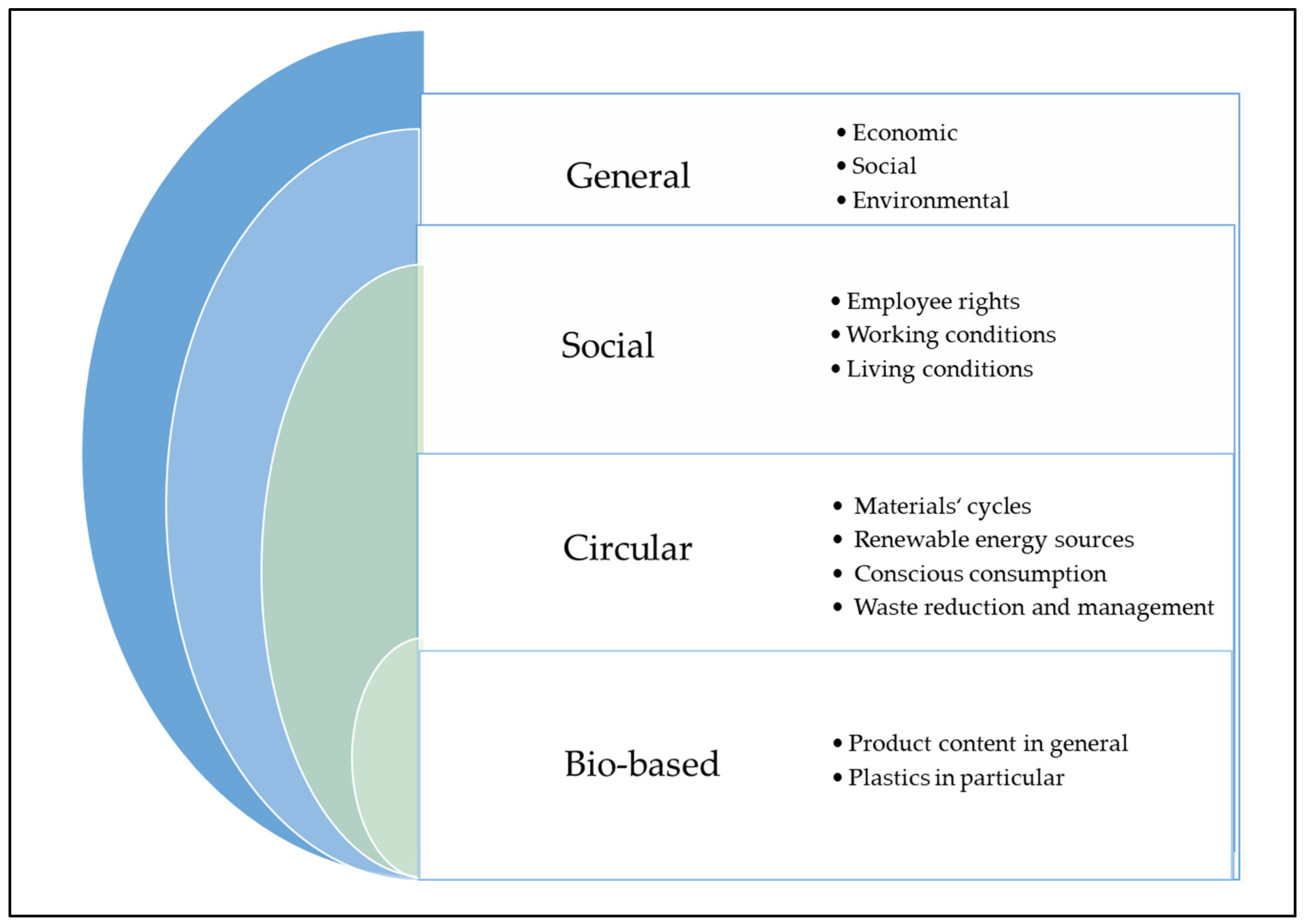
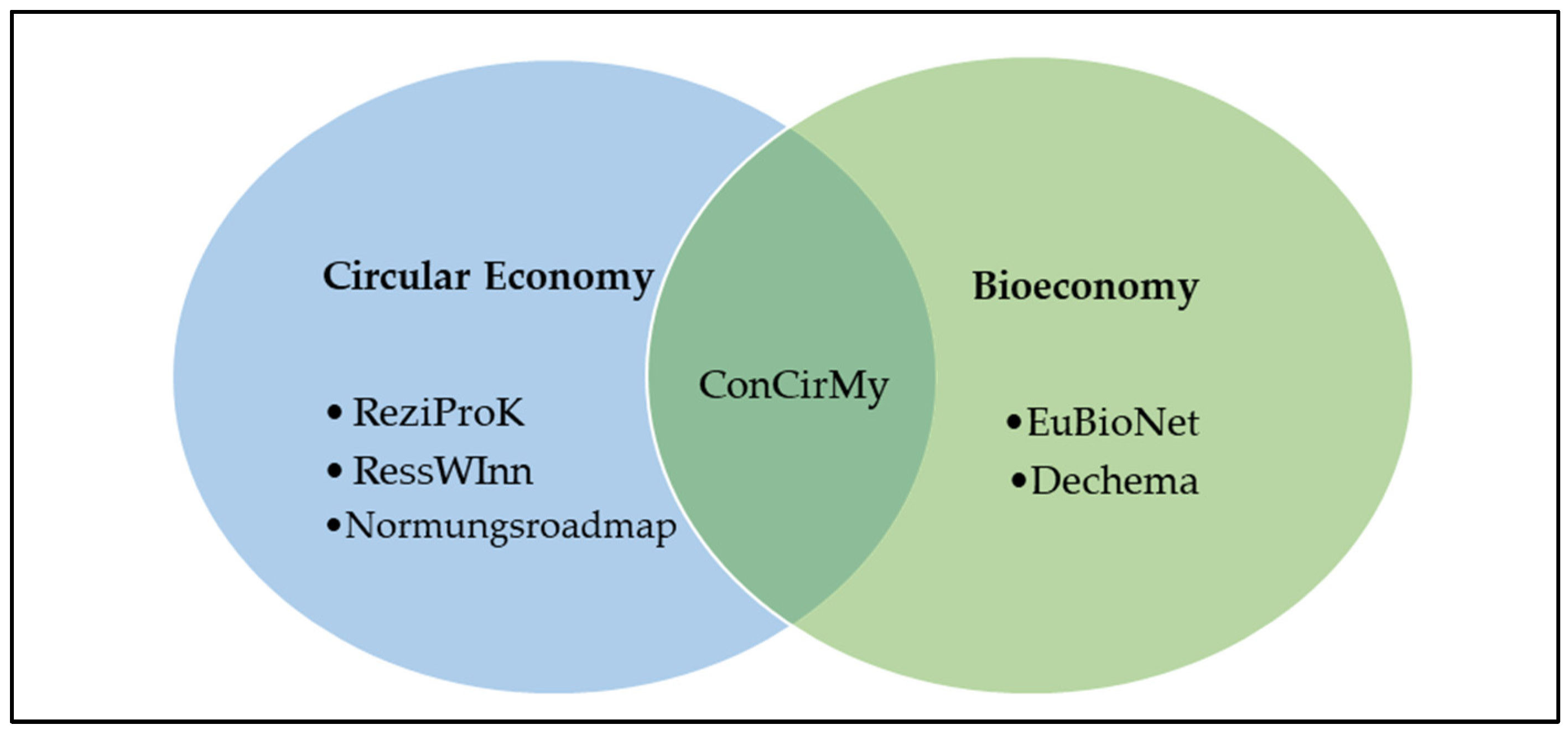
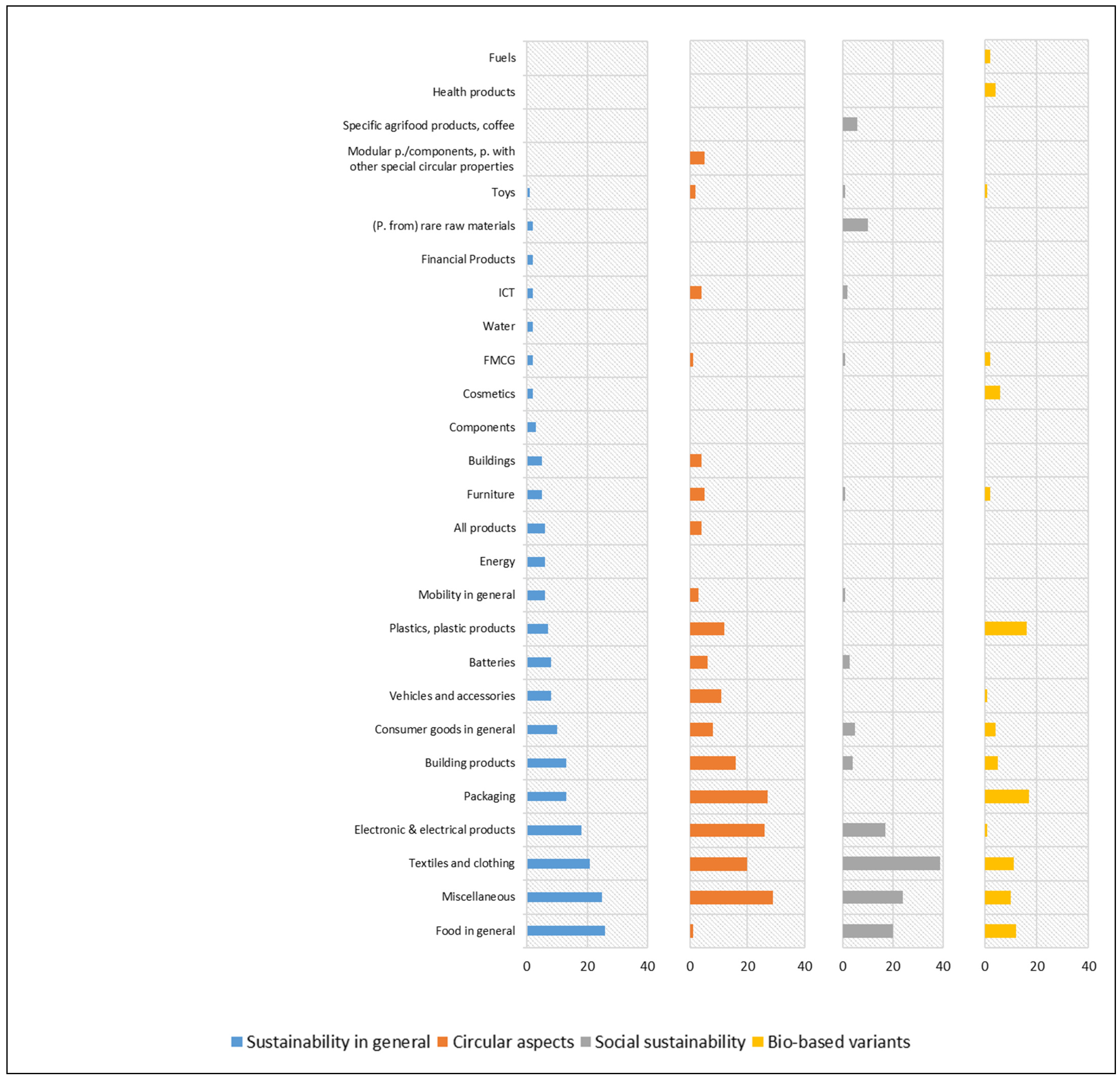
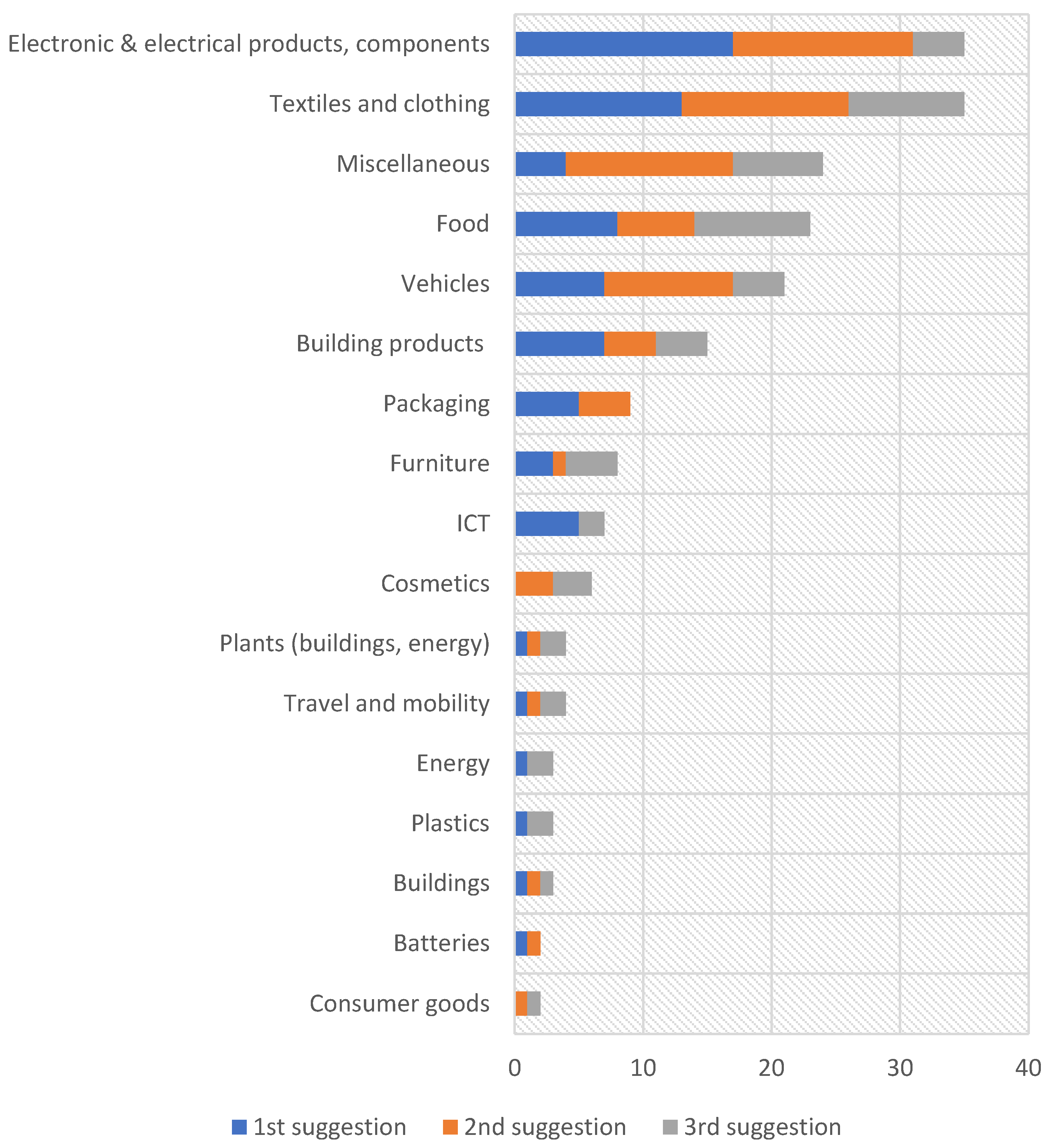
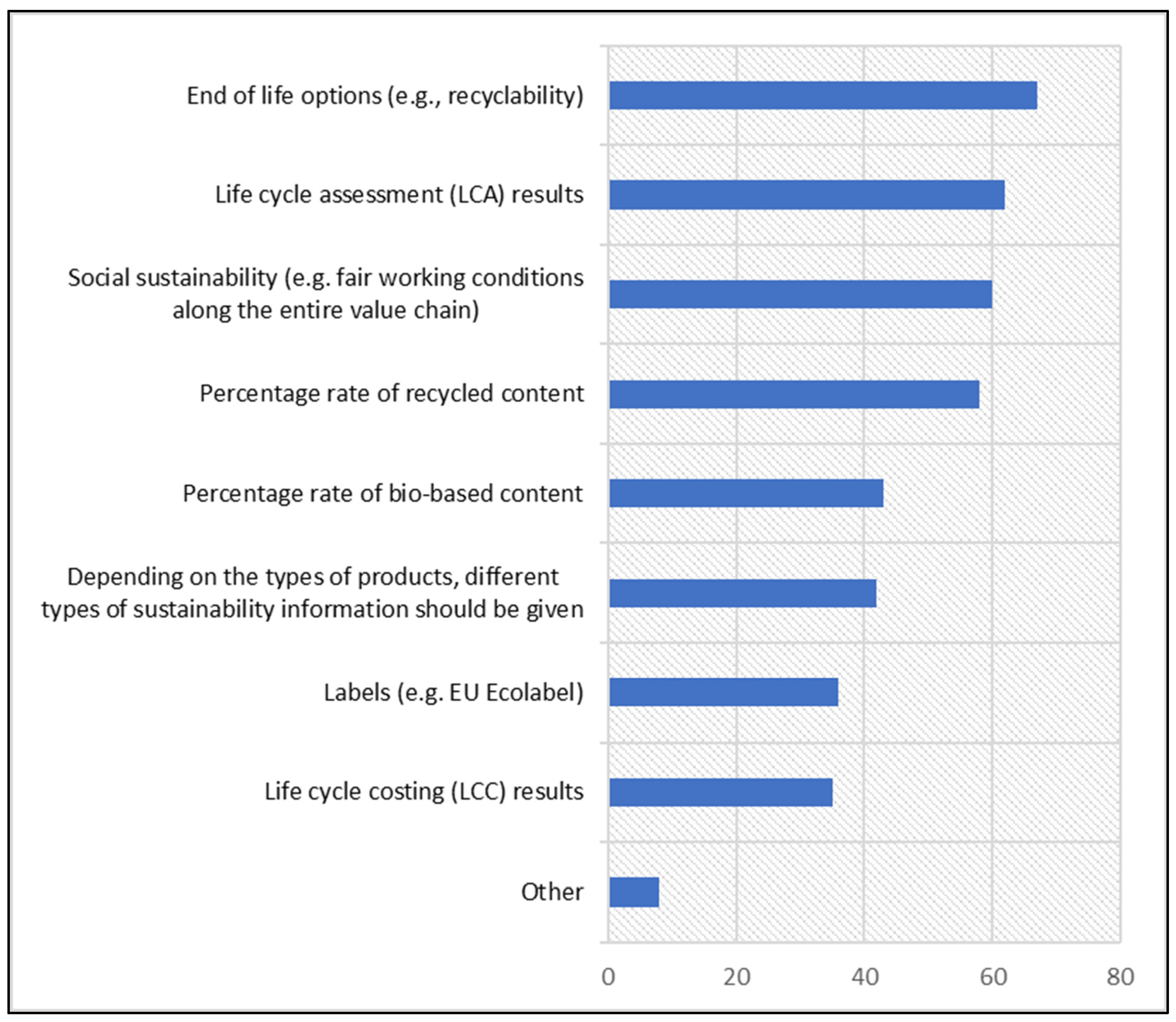
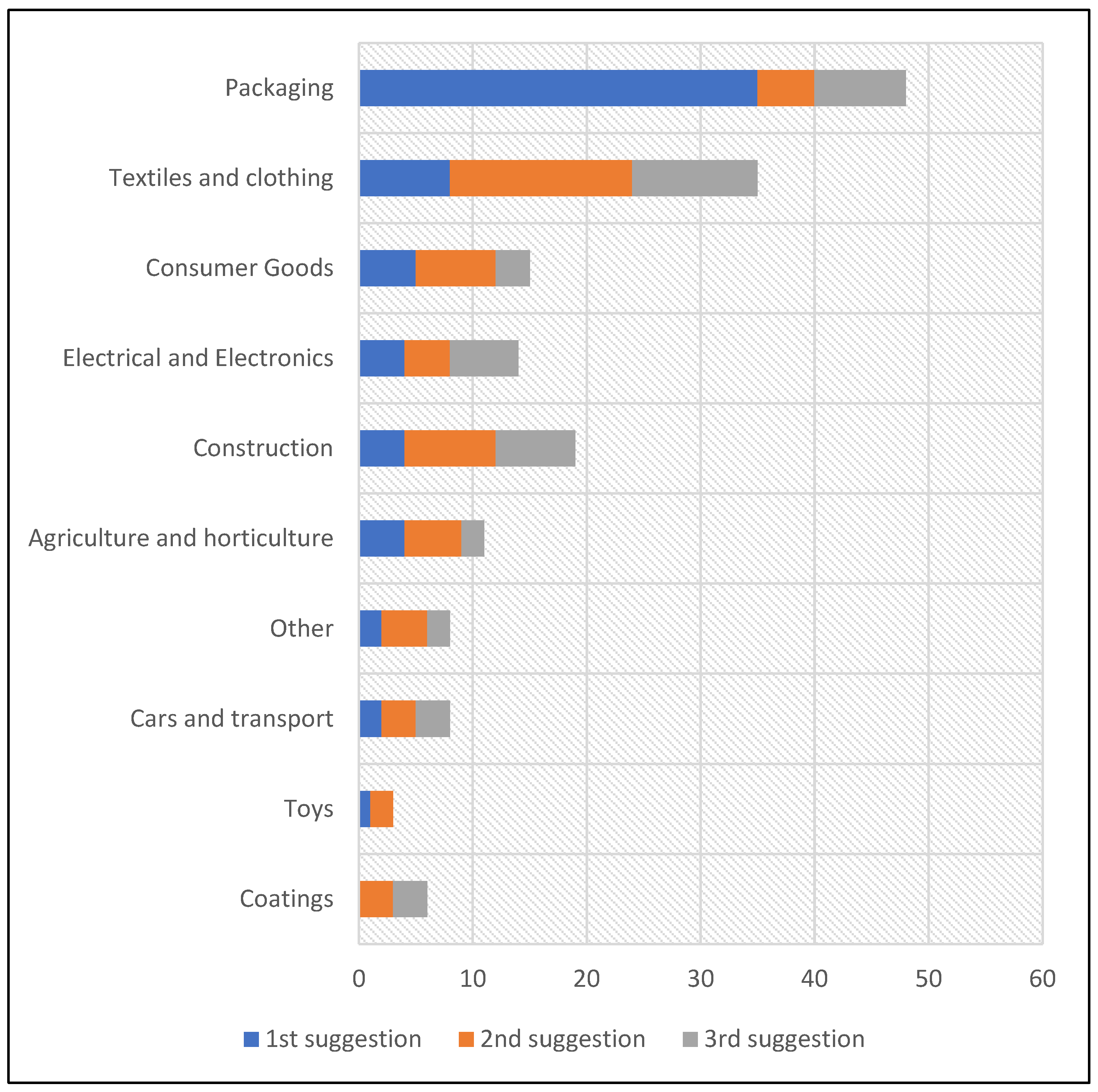
| Introduction |
|
| Software to support sustainable product selection decisions |
|
| Additional information on the participants |
|
| Occupation | Type of Organization | ||
|---|---|---|---|
| R&D | 45% | University or research institution | 41% |
| Other | 24% | Company | 40% * |
| Management | 19% | NGO | 6% |
| Marketing | 4% | Gov., public authority/agency | 6% |
| No answer | 4% | Other | 5% |
| Production | 2% | Industry association | 1% |
| Admin./accounting | 1% | ||
| Distribution | 1% | ||
| n = 134 | n = 80 ** | ||
| Sustainability in General | Circular Econ. Aspects | Social Sustainability | Bio-Based Variants |
|---|---|---|---|
Energy-related
| Energy-related
| Energy-related
| Energy-related
|
| 1. Selected reasons for the top-ranked categories. |
| General information on SMCG and complex products, including e.g., electrical appliances |
Energy aspects
|
| Electronic & electrical products, components |
Energy aspects
|
Various
|
| Textiles/clothing |
Consumer products
|
| Food |
High sales quantities
|
| 2. Selected reasons for the other categories. |
| General information on SMCG and complex products, including cars |
Energy aspects
|
| Cars |
Various
|
| Building materials |
High sales quantities
|
| Furniture |
Various
|
| 3. Supplementary explanations on products mentioned by individuals. |
| Smartphones |
|
| Outdoor products |
|
|
|
|
|
|
|
|
|
|
|
|
|
|
|
|
|
|
|
|
|
|
Publisher’s Note: MDPI stays neutral with regard to jurisdictional claims in published maps and institutional affiliations. |
© 2022 by the authors. Licensee MDPI, Basel, Switzerland. This article is an open access article distributed under the terms and conditions of the Creative Commons Attribution (CC BY) license (https://creativecommons.org/licenses/by/4.0/).
Share and Cite
Wurster, S.; Reis, C.F.d.B. Priority Products for Sustainability Information and Recommendation Software: Insights in the Context of the EU’s Action Plan Circular Economy. Sustainability 2022, 14, 11951. https://doi.org/10.3390/su141911951
Wurster S, Reis CFdB. Priority Products for Sustainability Information and Recommendation Software: Insights in the Context of the EU’s Action Plan Circular Economy. Sustainability. 2022; 14(19):11951. https://doi.org/10.3390/su141911951
Chicago/Turabian StyleWurster, Simone, and Cristina Fróes de Borja Reis. 2022. "Priority Products for Sustainability Information and Recommendation Software: Insights in the Context of the EU’s Action Plan Circular Economy" Sustainability 14, no. 19: 11951. https://doi.org/10.3390/su141911951
APA StyleWurster, S., & Reis, C. F. d. B. (2022). Priority Products for Sustainability Information and Recommendation Software: Insights in the Context of the EU’s Action Plan Circular Economy. Sustainability, 14(19), 11951. https://doi.org/10.3390/su141911951







